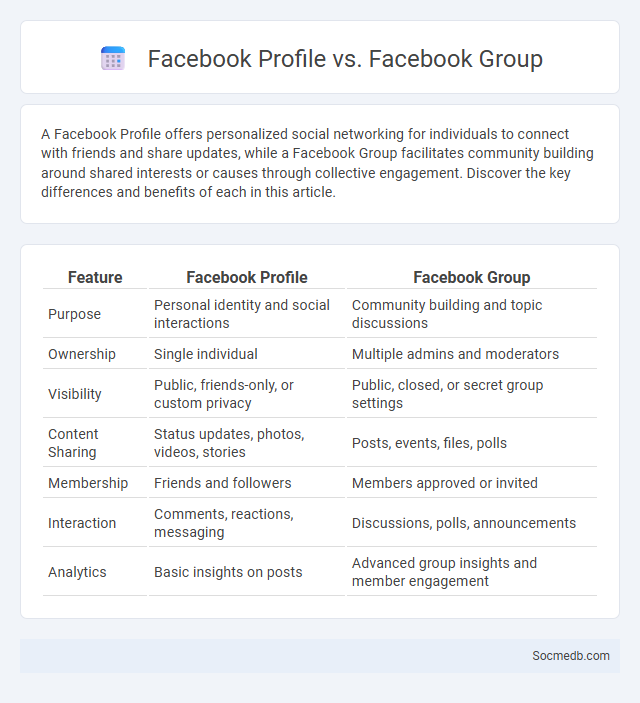
Photo illustration: Facebook Profile vs Facebook Group
A Facebook Profile offers personalized social networking for individuals to connect with friends and share updates, while a Facebook Group facilitates community building around shared interests or causes through collective engagement. Discover the key differences and benefits of each in this article.
Table of Comparison
| Feature | Facebook Profile | Facebook Group |
|---|---|---|
| Purpose | Personal identity and social interactions | Community building and topic discussions |
| Ownership | Single individual | Multiple admins and moderators |
| Visibility | Public, friends-only, or custom privacy | Public, closed, or secret group settings |
| Content Sharing | Status updates, photos, videos, stories | Posts, events, files, polls |
| Membership | Friends and followers | Members approved or invited |
| Interaction | Comments, reactions, messaging | Discussions, polls, announcements |
| Analytics | Basic insights on posts | Advanced group insights and member engagement |
Introduction to Facebook Profiles, Groups, and Pages
Facebook profiles serve as personal digital identities where users share photos, posts, and life updates. Groups facilitate communities based on shared interests, enabling members to interact through posts, comments, and events within focused discussions. Pages provide businesses, brands, and public figures a dedicated platform to connect with followers through posts, promotions, and customer engagement.
Defining Facebook Profiles: Features and Uses
Facebook profiles serve as personalized digital identities, featuring customizable bios, profile and cover photos, and a timeline showcasing your posts and interactions. Users can share updates, photos, videos, and links, while privacy settings control who views your information and activity. These profiles facilitate social networking, content sharing, and connecting with friends, family, and communities across the platform.
Overview of Facebook Groups: Community Building Explained
Facebook Groups serve as dynamic platforms for community building, enabling users to connect around shared interests, causes, or goals. These groups facilitate direct interaction, content sharing, and collaboration, enhancing engagement through features like discussions, events, and polls. They play a critical role in fostering loyalty and support within niche communities on the Facebook social media ecosystem.
Understanding Facebook Pages: Brand and Business Presence
Facebook Pages offer businesses and brands a dedicated platform to connect with their audience, showcase products, and share updates. Optimizing your Facebook Page with accurate contact details, engaging content, and consistent branding enhances visibility and customer interaction. Leveraging insights and advertising tools empowers you to tailor your marketing strategy and increase reach effectively.
Key Differences: Profile vs Group vs Page
Social media profiles represent individual users, allowing personal sharing and direct interactions with friends or followers, while pages serve as public profiles for businesses, brands, or organizations to broadcast updates and engage a broader audience. Groups facilitate community building by enabling members with shared interests to participate in discussions, share content, and collaborate privately or publicly. Profiles emphasize personal identity, pages focus on brand promotion, and groups prioritize interactive community engagement.
Privacy and Control: Managing Visibility and Membership
Your privacy on social media platforms is safeguarded through customizable settings that allow you to control who can see your posts and profile information. Managing membership in groups or communities ensures you can selectively permit access, maintaining a secure digital environment. By adjusting visibility options and membership controls, you protect your personal data and enhance your overall online experience.
Engagement and Interaction: Audience Communication
Effective audience communication on social media significantly enhances engagement and interaction metrics, driving higher reach and brand loyalty. Utilizing interactive content such as polls, Q&A sessions, and live videos encourages active participation and fosters a community atmosphere. Timely responses and personalized interactions further improve user experience, increasing retention and positive sentiment across platforms.
Content Sharing and Reach: Distribution Strategies
Effective content sharing on social media relies on targeted distribution strategies that maximize reach and engagement. Utilizing platform-specific algorithms, branded hashtags, and scheduled posting times enhances visibility across diverse audience segments. Collaborative partnerships and influencer endorsements further amplify content dissemination, leading to exponential reach growth and brand awareness.
Best Use Cases: When to Choose Profile, Group, or Page
Choosing between a social media profile, group, or page depends on your specific goals and audience engagement needs. Profiles work best for personal branding and direct interactions, groups foster community and discussions around shared interests, and pages effectively represent businesses or organizations with broad public visibility and marketing capabilities. Understanding these distinctions helps you optimize your social media strategy to maximize reach, interaction, and growth.
Conclusion: Selecting the Right Facebook Tool for Your Goals
Selecting the right Facebook tool hinges on aligning its features with your specific marketing objectives, whether boosting engagement, automating posts, or analyzing audience insights. Tools like Facebook Business Suite excel in comprehensive page management, while platforms such as Hootsuite or Buffer offer robust scheduling and multi-channel integration. Prioritizing tools that provide detailed analytics and user-friendly interfaces ensures efficient campaign execution and measurable growth in social media presence.
 socmedb.com
socmedb.com